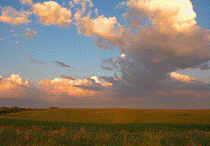
Proceedings of the North American Prairie Conferences
Date of this Version
1989
Document Type
Article
Abstract
Breeding birds were censused yearly from 1974-1988 on a 10.1 ha floodplain tallgrass prairie, a portion of the Baker Wetlands Research Area on the south edge of Lawrence, Kansas. Dickcissels (Spiza americana) were the most abundant species, with densities about six times greater than in the Flint Hills tallgrass prairie (149 territorial males/km2 VS. 25/ km2). This may be due to availability of moisture and associated density of grass stems and insect production. The bird community in the floodplain prairie however, is less diverse (5 species VS. 10 species). Grasshopper sparrows (Ammodramus savannarum) were the second most abundant species in Flint Hills upland prairie, but were absent from floodplain prairie. Red-winged blackbirds (Agelaius phoeniceus) which are rarely censused in upland prairie were the second most abundant species in floodplain prairie. Population densities were relatively stable over 15 years with exceptions due to different land use patterns in the vicinity of the study plot and burning or mowing of the prairie prior to the nesting season.


Comments
Published in Prairie Pioneers: Ecology, History and Culture: Proceedings of the Eleventh North American Prairie Conference, August 7-11, 1988, Lincoln, Nebraska (Lincoln, NE 1989).